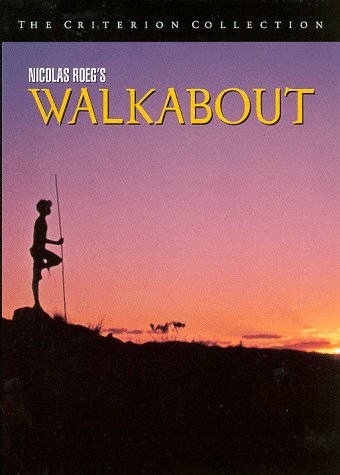

Walkabout (Nicholas Roeg, 1971) prod. Si Litvinoff, Max L. Raab & Si Litvinoff Films, wr. Edward Bond, novel James Vance Marshall, dp Nicolas Roeg, music John Barry, design Terry Gough, ed. Anthony Gibbs, Alan Patillo; Jenny Agutter, Lucien John [Roeg], David Gulpilil, John Meillon, Noelene Brown, Peter Carver, Barry Donnelly; influential UK production about two white Australian children stranded in desert and helped to safety by young Aborigine, played by David Gulpilil; 100 min.
Another view of Australia from a foreigner - before we had any views ourselves - this remains admirably poetic - despite some Roegish exploitation.
For years when I was asked which was my 'favourite' Australian film, I had an answer ready: two films whose titles both begin with the letter W, and which were both released in the same annus mirabilis: 1971. I mean Walkabout, and Wake in Fright.
Walkabout was among the first films of the (Oz cinema) Renaissance to be released on DVD, and as soon as I could get it, I listened with fascination to the commentary of director Nicholas Roeg and actor Jenny Agutter. Unfortunately there is nothing from the real star of the film, David Gulpilil.
While it has many fine qualities, my personal view is that Walkabout also has exploitation aspects. There are two long nude (or almost nude) scenes, one of which is in my view largely gratuitous. The scene in which the boy woos the girl with his courtship dance (with his genitals barely covered) is definitely part of the plot, and it also draws attention to (and exploits, if you like) the beauty of the body of the slim, healthy, young Aboriginal. However, the scene in which the (white) girl swims naked in the large rock pool is harder to justify.
Roeg would say, as the film itself does explicitly say in its epilogue from A.E. Housman, that he’s offering a vision of a lost Eden. (”That is the land of lost content, I see it shining plain, the happy highways where I went and cannot come again.” But Housman is talking about Shropshire!) The swimming scene is intercut with others in which Gulpilil’s character is seen killing various animals for food. The male is the hunter/gatherer, while the female seems to have all the time in the world to play and enjoy her slim, healthy, young body.
Well and good, as far it goes, but this is a commercial film made and sold by an industry which has always exploited female nudity to attract attention and increase the return to investors. Walkabout is only different in this scene from pornography by degree, not in kind.
I’ve never discussed this with anyone who agrees with me, so see it yourself and you’ll prolly disagree too. You should see it, however: in my opinion (and I’ve seen hundreds of Australian films) it’s one of handful of ten or twelve films that I would see as the best of Australian cinema.
See also my 'presentation' on Indigenous issues in Australian film.
Garry Gillard | New: 1 October, 2012 | Now: 2 December, 2019